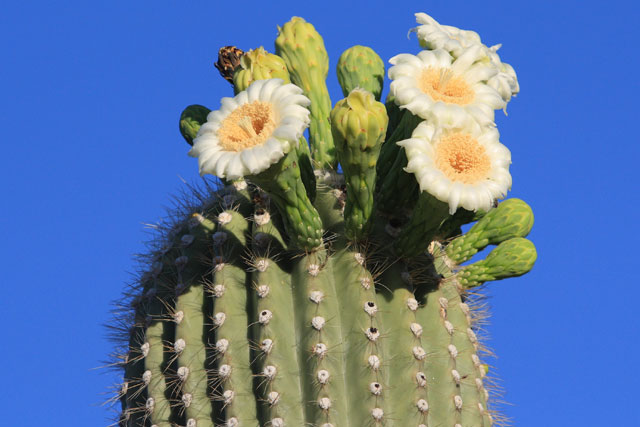The natural habitats of cacti are the dry lands of North and South America. Cacti have been introduced to many other parts of the world. In Australia the prickly pear cactus was introduced, and has grown so well that it has become a pest.
One way of seeing how well a cactus is adapted to a dry habitat is to compare it with a plant that can only live where there is some moisture all through the year. A plant loses water though its leaves. If there is plenty of water in the soil this is not a problem, and the plant may have huge numbers of large leaves. The leaves may be set out on a large branching stem like that of a broad-leaved tree. This arrangement of leaves and stem is totally unsuitable for living in dry conditions. Here any water that the plant can collect must be stored and used sparingly. The cactus has adapted to these conditions by modifying its stems to hold onto as much water as it can.
The cactus does not have leaves to make food; it uses its stem instead. This adaptation greatly reduces water loss. The stem of the cactus also has a thick waxy surface which stops water passing through it. Most cacti do not have branches. This reduces the area of the stem through which water can pass. In fact many cacti make the surface area of their stems as small as possible by having it in the shape of a dome, and growing close to the ground. One cactus that grows in the Mexican desert even sinks below ground in the dry season and grows above ground again after rain.
The stem of a cactus has spaces for storing water, and a skin which can change shape as the amount of water changes, rather like a concertina. When the cactus has little water stored, the surface of the stem has deep grooves in it. But as more water is stored, the stem swells up and the grooves become much less deep.
The cactus defends its store of water from animals by having spines. They cut into any animal that tries to bite through to the water store. The spines also cast a shadow across the surface, cooling the plant down a little, and reducing loss of water by evaporation. Some cacti reduce evaporation further by growing a woolly material among their spines. This traps a layer of air close to the spines which stops some of the Sun's heat reaching the surface (air is an insulator).







